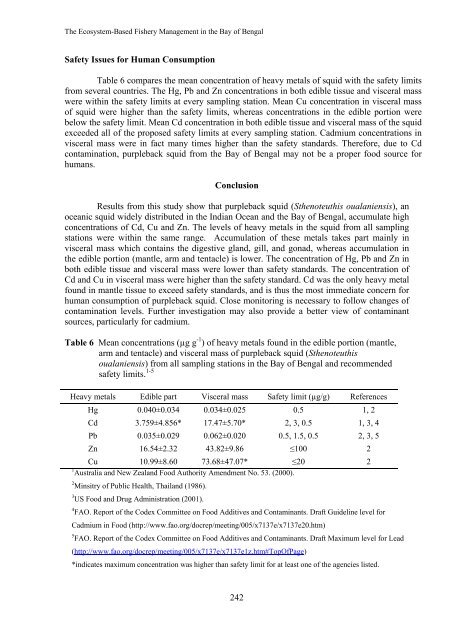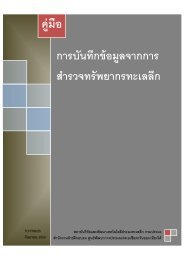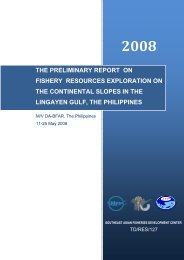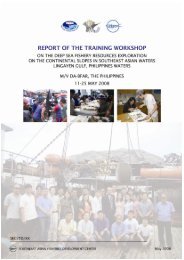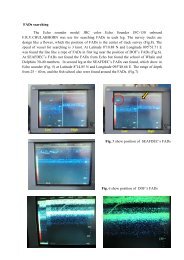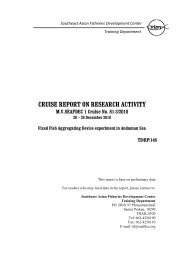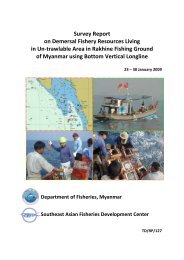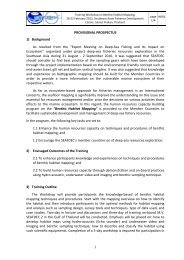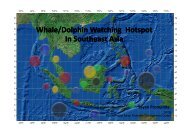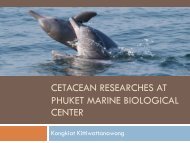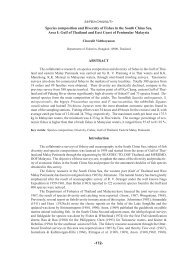Download - fisheries information system - Seafdec
Download - fisheries information system - Seafdec
Download - fisheries information system - Seafdec
You also want an ePaper? Increase the reach of your titles
YUMPU automatically turns print PDFs into web optimized ePapers that Google loves.
The Eco<strong>system</strong>-Based Fishery Management in the Bay of Bengal<br />
Safety Issues for Human Consumption<br />
Table 6 compares the mean concentration of heavy metals of squid with the safety limits<br />
from several countries. The Hg, Pb and Zn concentrations in both edible tissue and visceral mass<br />
were within the safety limits at every sampling station. Mean Cu concentration in visceral mass<br />
of squid were higher than the safety limits, whereas concentrations in the edible portion were<br />
below the safety limit. Mean Cd concentration in both edible tissue and visceral mass of the squid<br />
exceeded all of the proposed safety limits at every sampling station. Cadmium concentrations in<br />
visceral mass were in fact many times higher than the safety standards. Therefore, due to Cd<br />
contamination, purpleback squid from the Bay of Bengal may not be a proper food source for<br />
humans.<br />
Conclusion<br />
Results from this study show that purpleback squid (Sthenoteuthis oualaniensis), an<br />
oceanic squid widely distributed in the Indian Ocean and the Bay of Bengal, accumulate high<br />
concentrations of Cd, Cu and Zn. The levels of heavy metals in the squid from all sampling<br />
stations were within the same range. Accumulation of these metals takes part mainly in<br />
visceral mass which contains the digestive gland, gill, and gonad, whereas accumulation in<br />
the edible portion (mantle, arm and tentacle) is lower. The concentration of Hg, Pb and Zn in<br />
both edible tissue and visceral mass were lower than safety standards. The concentration of<br />
Cd and Cu in visceral mass were higher than the safety standard. Cd was the only heavy metal<br />
found in mantle tissue to exceed safety standards, and is thus the most immediate concern for<br />
human consumption of purpleback squid. Close monitoring is necessary to follow changes of<br />
contamination levels. Further investigation may also provide a better view of contaminant<br />
sources, particularly for cadmium.<br />
Table 6 Mean concentrations (µg g -1 ) of heavy metals found in the edible portion (mantle,<br />
arm and tentacle) and visceral mass of purpleback squid (Sthenoteuthis<br />
oualaniensis) from all sampling stations in the Bay of Bengal and recommended<br />
safety limits. 1-5<br />
Heavy metals Edible part Visceral mass Safety limit (µg/g) References<br />
Hg 0.040±0.034 0.034±0.025 0.5 1, 2<br />
Cd 3.759±4.856* 17.47±5.70* 2, 3, 0.5 1, 3, 4<br />
Pb 0.035±0.029 0.062±0.020 0.5, 1.5, 0.5 2, 3, 5<br />
Zn 16.54±2.32 43.82±9.86 ≤100 2<br />
Cu 10.99±8.60 73.68±47.07* ≤20 2<br />
1 Australia and New Zealand Food Authority Amendment No. 53. (2000).<br />
2<br />
Minsitry of Public Health, Thailand (1986).<br />
3<br />
US Food and Drug Administration (2001).<br />
4<br />
FAO. Report of the Codex Committee on Food Additives and Contaminants. Draft Guideline level for<br />
Cadmium in Food (http://www.fao.org/docrep/meeting/005/x7137e/x7137e20.htm)<br />
5<br />
FAO. Report of the Codex Committee on Food Additives and Contaminants. Draft Maximum level for Lead<br />
(http://www.fao.org/docrep/meeting/005/x7137e/x7137e1z.htm#TopOfPage)<br />
*indicates maximum concentration was higher than safety limit for at least one of the agencies listed.<br />
242


